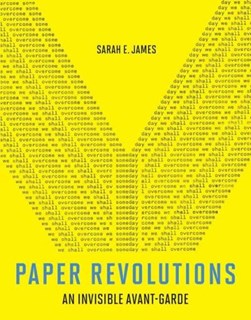-
BROWSE 1000s OF BOOKS IN STOCK
-
FREE DELIVERY ON ORDERS OVER €10
Paper revolutions
Hardback
In Paper Revolutions, Sarah James offers a radical rethinking of experimental art in the early years of the former East Germany (the GDR). Countering conventional accounts that claim artistic practices in the GDR were isolated and conservative, James introduces a new narrative of neo-avantgarde practice in the Eastern Bloc that subverts many of the assumptions underpinning Western art's postwar histories. She grounds her argument in the practice of four artists who, uniquely positioned outside academies, museums, and the art market, created art in the blind spots of state censorship. They championed ephemeral practices often marginalised by critics: postcards and letters, maquettes and models, portfolios and artists' books. Through their "lived modernism," they produced bodies of work animated by the radical legacies of the interwar avant-garde. James examines the work and daily practices of the constructivist graphic artist, painter, and sculptor Hermann Glöckner; the experimental graphic artist, concrete and sound poet Carlfriedrich Claus; the mail artist, concrete poet, and conceptual artist Ruth Wolf-Rehfeldt; and the mail artist, "visual poet," and installation artist Karla Sachse. She shows that all of these artists, despite their lack of political status, took a stance that was not apolitical but socialist, even utopian. They believed in the radical potential of art to create collectivised experiences and fought against the idea of art as a commodity or a rarefied object. James argues that these artists, entirely neglected by Western art history, produced some of the most significant experimental art that emerged from the GDR.
€37.12
Was €46.40

111 Reward Points
In stock online
Extended Range: Delivery in 2-3 working days
Extended Range: Delivery in 2-3 working days
Free Delivery on this item
Any purchases for more than €10 are eligible for free delivery anywhere in the UK or Ireland!
In Paper Revolutions, Sarah James offers a radical rethinking of experimental art in the early years of the former East Germany (the GDR). Countering conventional accounts that claim artistic practices in the GDR were isolated and conservative, James introduces a new narrative of neo-avantgarde practice in the Eastern Bloc that subverts many of the assumptions underpinning Western art's postwar histories. She grounds her argument in the practice of four artists who, uniquely positioned outside academies, museums, and the art market, created art in the blind spots of state censorship. They championed ephemeral practices often marginalised by critics: postcards and letters, maquettes and models, portfolios and artists' books. Through their "lived modernism," they produced bodies of work animated by the radical legacies of the interwar avant-garde. James examines the work and daily practices of the constructivist graphic artist, painter, and sculptor Hermann Glöckner; the experimental graphic artist, concrete and sound poet Carlfriedrich Claus; the mail artist, concrete poet, and conceptual artist Ruth Wolf-Rehfeldt; and the mail artist, "visual poet," and installation artist Karla Sachse. She shows that all of these artists, despite their lack of political status, took a stance that was not apolitical but socialist, even utopian. They believed in the radical potential of art to create collectivised experiences and fought against the idea of art as a commodity or a rarefied object. James argues that these artists, entirely neglected by Western art history, produced some of the most significant experimental art that emerged from the GDR.

111 Reward Points
Any purchases for more than €10 are eligible for free delivery anywhere in the UK or Ireland!
€37.12
Was €46.40

111 Reward Points
Any purchases for more than €10 are eligible for free delivery anywhere in the UK or Ireland!
Product Description
In Paper Revolutions, Sarah James offers a radical rethinking of experimental art in the early years of the former East Germany (the GDR). Countering conventional accounts that claim artistic practices in the GDR were isolated and conservative, James introduces a new narrative of neo-avantgarde practice in the Eastern Bloc that subverts many of the assumptions underpinning Western art's postwar histories. She grounds her argument in the practice of four artists who, uniquely positioned outside academies, museums, and the art market, created art in the blind spots of state censorship. They championed ephemeral practices often marginalised by critics: postcards and letters, maquettes and models, portfolios and artists' books. Through their "lived modernism," they produced bodies of work animated by the radical legacies of the interwar avant-garde. James examines the work and daily practices of the constructivist graphic artist, painter, and sculptor Hermann Glöckner; the experimental graphic artist, concrete and sound poet Carlfriedrich Claus; the mail artist, concrete poet, and conceptual artist Ruth Wolf-Rehfeldt; and the mail artist, "visual poet," and installation artist Karla Sachse. She shows that all of these artists, despite their lack of political status, took a stance that was not apolitical but socialist, even utopian. They believed in the radical potential of art to create collectivised experiences and fought against the idea of art as a commodity or a rarefied object. James argues that these artists, entirely neglected by Western art history, produced some of the most significant experimental art that emerged from the GDR.
Product Details
ISBN9780262046565
FormatHardback
PublisherTHE MIT PRESS (17 March. 2022)
No. of Pages387
Weight1088
Language English
Dimensions 229 x 178 x 36

